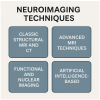Hydrocephalus: Molecular and Neuroimaging Biomarkers in Diagnosis and Management
- PMID: 40722587
- PMCID: PMC12292470
- DOI: 10.3390/biomedicines13071511
Hydrocephalus: Molecular and Neuroimaging Biomarkers in Diagnosis and Management
Abstract
Hydrocephalus is a complex neurological condition marked by abnormal cerebrospinal fluid (CSF) accumulation, often leading to elevated intracranial pressure and structural brain damage. Despite advances in surgical treatment, diagnostic precision and prognosis remain challenging, especially in idiopathic normal pressure hydrocephalus (iNPH). This narrative review aims to synthesize the current knowledge regarding molecular and neuroimaging biomarkers that hold diagnostic, prognostic, and therapeutic significance in hydrocephalus. A comprehensive literature search was conducted across PubMed, Scopus, Web of Science, and Google Scholar. The inclusion criteria encompassed peer-reviewed studies involving congenital or acquired hydrocephalus and reporting on mechanistic, diagnostic, or monitoring biomarkers. Both established and emerging biomarkers were included, and preclinical findings were considered when translational relevance was apparent. The review highlights a broad spectrum of molecular markers including aquaporins, vascular endothelial growth factor, neurofilaments, glial fibrillary acidic protein, matrix metalloproteinases, and neuroinflammatory markers. The genetic markers associated with ciliogenesis also show promise in subtyping disease. Parallel to molecular advances, neuroimaging techniques, ranging from classic markers like Evans' index to advanced modalities such as diffusion tensor imaging (DTI), arterial spin labeling (ASL), and glymphatic MRI, provide functional perspectives on hydrocephalus diagnosis and management, while artificial intelligence may further enhance diagnostic algorithms. Molecular and imaging markers could not only increase diagnostic confidence, but also provide information on disease causes and progression. As research progresses, merging various methodologies may result in more accurate diagnoses.
Keywords: CSF; CT; MRI; biomarkers; genetic markers; hydrocephalus; molecular markers; neuroimaging markers; neurological disease; normal pressure hydrocephalus.
Conflict of interest statement
The authors declare no conflicts of interest.
Figures



References
Publication types
LinkOut - more resources
Full Text Sources
Research Materials

